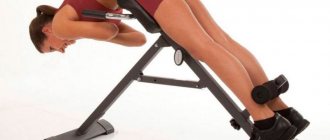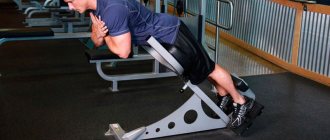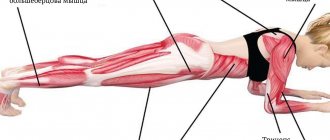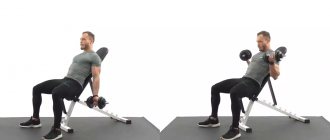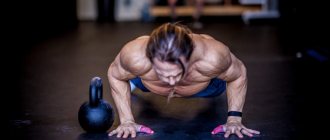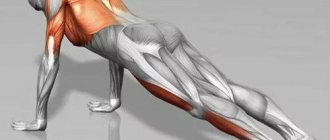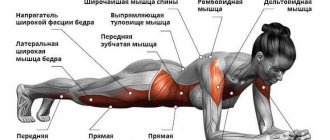All gym goers are familiar with the exercise on a special simulator. Time, distance and other factors make it impossible to visit the hall. And it is very difficult to adapt certain exercises to suit home conditions, especially those performed in a simulator. But even at home you can perform hyperextension without special equipment. It is known that the exercise perfectly strengthens the back surface of the body, without compression on the spine. So why not incorporate variations of it into your home workouts?
What muscles does hyperextension work?
I mentioned earlier that depending on the location of the pelvis on the bench, the emphasis between the muscles will shift. In the classic version of hyperextensions, movement was meant specifically in the hip joint. Therefore, initially its implementation was aimed at developing the gluteal muscles.
. It is due to their contraction that extension of the torso occurs. In order to achieve this, you should correctly position your pelvis on the bench. As a guide, let’s take the upper edges of the iliac bones protruding in the waist area. They should protrude slightly beyond the far edge of the machine's support pad. This way we can freely bend the torso at the hip joint, while stretching the gluteal muscles.
In addition to the pelvic muscles, hyperextension allows you to stretch the spinal extensors
. These are the deep back muscles that are responsible for stabilizing the spine when in an upright position. Their development plays an important role. Most basic exercises such as: DEADLIFT, SQUAT WITH A BAR ON THE SHOULDER or FRONTAL create a large compression load on the spine. And with weak extensors, this can eventually lead to back injuries, especially in the lumbar region. Performing hyperextension has the opposite effect, allowing the spine to stretch (decompress) at the bottom. In ordinary life, this effect is very difficult to achieve. Since we need to somehow fix the pelvis so that it does not lean forward at the moment of tilting. The hyperextension machine gives us this opportunity. To do this, we must position ourselves on the support pad so that the ilia lie below the far edge. In addition to the main muscle groups, the following are involved in the work:
- Biceps femoris muscle. Works dynamically, helping the gluteus maximus straighten the torso.
- Abdominal muscles. Act as spinal stabilizers.
Differences from deadlift
Many equate these two exercises, because both movements are designed to pump up the lower back.
In fact, the movements are so different that they cannot even be compared.
The deadlift is a basic complex exercise that involves almost all muscle groups (about 400 muscles). Here are the hips, buttocks, back and abs.
But hyperextension is an isolating movement that loads the hamstrings, buttocks and psoas muscles. The biomechanics of the movement are completely different from the deadlift.
As a result, the deadlift is used in the training process to increase the overall level of strength of the whole body and gain muscle mass.
And hyperextension is for isolated pumping of the lumbar muscles or accentuated work on the back of the thigh and buttocks.
Benefits of exercise
In order to understand whether it is worth spending time on performing hyperextension. We need to find out what benefit it will bring to us.
- Hyperextension makes it possible to work out the gluteus maximus and hamstrings in isolation.
- By changing the height of the bench, we can work on strengthening the back extensors. No other exercise will give you this opportunity. This will improve your posture and reduce the risk of injury in the lumbar region when performing basic exercises.
- It is actively performed by security forces and weightlifters for pain in the lumbar region. Before using hyperextension for medicinal purposes, you should consult your doctor.
- The endurance of the back extensors increases, especially if you perform the exercise with a slight delay at the top point. Giving the muscles the opportunity to work statically.
- Due to its simplicity, it can be adapted for use at home.
That is, by performing such a technically simple exercise, we can strengthen the back extensors and gluteal muscles. Thanks to this, our performance in basic exercises will increase, and the risk of injuring the lower back will be reduced to a minimum. Plus, correct posture will give us an even more expressive appearance. This exercise will only take you 5 minutes to complete. In my opinion, hyperextension is a good ratio of the allocated time and the result obtained.
Types of hyperextension machines
Before you start mastering the technique, it’s worth saying a few words about the simulator itself. It comes in two types:
- Exercise machine with an incline of 45°. This type of exercise machine is more suitable for beginner athletes. The 45° angle makes it easier to control the tilt depth. This is especially important for athletes with poor flexibility. Most often, this bench is used by girls to train their gluteal muscles and by beginners to learn the technique.
- Horizontal trainer. It's more difficult to work in. Due to the horizontal position of the body at the top point, greater static tension is created in the target muscles. Also, in this simulator you can perform reverse hyperextension, but we will talk about this later.
Extension and hyperextension - the difference
Due to the fact that many terms are unknown to most people, and especially to novice athletes, many questions arise. For example, many people think that hyperextension and extension are different exercises, but in fact they are not. If the meaning of the first term is clear, then the second means straightening and extension. From this we can conclude that the two presented concepts describe the same action, since hypertension is also an extension of the body. The term “extension” is also applicable to other exercises.
Technique for performing hyperextension
Now that we have studied all the important points, we can move on to the execution technique. Decide for yourself which bench you will work on. It is also very important to decide which muscles you are going to work. We will analyze two options for performing the back muscles and gluteal muscles.
Starting position with emphasis on the gluteal muscles:
- Adjust the support pads to such a height that their farthest edge is just below the ilia.
- Place your feet under the special bolsters and rest the back of your shins against them.
- Stand with your feet on the platform. For greater stability, your heels should touch the top edge.
- Turn your feet out to the sides 45°. This will make it easier to squeeze your buttocks at the top of the movement.
- We cross our arms in front of our chest.
- The entire body should remain straight, from the heels to the crown.
Performance:
- We take a breath and begin to lean forward, stretching the gluteal muscle.
- Next, as you exhale, raise your torso to its original position. No need to overextend your back! This will not affect the functioning of the target muscles in any way.
- At the top point, squeeze the gluteal muscles together and take a short pause.
If you want to load your gluteal muscles even more, then you should round your back. By excluding the latissimus muscles and spinal extensors from the movement.
Starting position with emphasis on back extensors:
- The support pads should be adjusted so that their top edge is higher than the iliac bones.
- We secure the legs using special bolsters.
- The feet are parallel to each other.
- We stretch our arms in front of us or place them behind our backs.
- Our body in the starting position should be straight, from the heels to the head.
- The gaze is directed in front of you while performing.
Performance:
- As you exhale, slowly and under control we begin the movement from the head, tilting it down until the chin touches the chest.
- Then, we begin to round our back and at the same time bend forward.
- Next, as you exhale, perform reverse movements, unbend, straighten your back and lift your chin up.
- In the upper position, you must pause to allow the muscles to work statically.
There is another static option for performing hyperextension. It is performed on a horizontal bench. We are also located in the simulator. And we try to hold ourselves, due to static muscle tension in the starting position. We can say that this is a kind of PLANK, only it is performed on weight, and not in a prone position.
Errors
Try to avoid the mistakes that most beginners make:
- Large range of motion. You're going way up. And the body bends 15-25 degrees. This is fine if you've completed your last rep and want to stretch. Or you pull your abdominal muscles after training. There is no need to do this in working approaches - why create unnecessary stress for the spine.
- Fast jerky movements. We do the exercise slowly.
- We hold the weight near the forehead, behind the back of the head, or, generally, in front of the head. If you hold weight behind your head, the load on the spine increases. And if you take it further than the top of your head, also into your arms. It turns out that you are doing some kind of new base where almost all the muscles of the body work.
- Very often, beginners begin the exercise the first time with weights. First you need to work out the technique. Do 3 sets of 15–20 reps. Believe me, you won't find it enough.
Hyperextension options
In addition to the classic version, there are some variations of this exercise. We will analyze only the most popular among them.
Reverse hyperextension
Reverse hyperextension is an alternative to the classic version. Only now we raise and lower our legs, not our torso. Thanks to this implementation, the emphasis shifts to the lower part of the spinal extensors and gluteal muscles. If you have pain in the lumbar region due to a sedentary lifestyle or sedentary work. Then reverse hyperextension will be your weapon in solving this problem. Of course, we are not talking about serious spinal injuries. The reverse hyperextension machine comes in two types: with a lever on which additional weight is hung (for professional athletes) and without it (for beginners).
Performance:
- We lie down on the exercise machine so that the iliac bones rest against the edge of the support pillows. This will allow the hip joint to rotate freely.
- We hold special handles with our hands, and rest our elbows on soft pillows (if any).
- In the starting position, the legs are lowered down.
- As you exhale, raise your legs up until they are parallel to the floor. At the same time, at the top point we squeeze the gluteal muscles. We stay in this position for several seconds.
- Next, inhale and lower your legs to the starting position.
Hyperextension lying on the floor or “Boat” exercise
Unlike previous exercises, when performing the “boat”, we do not need special equipment. Therefore, this version of hyperextension can be done both in the gym and at home. Due to the small range of motion, the load in the exercise will be more static than dynamic. Therefore, it is necessary to take a long pause at the top point.
Performance:
- Lie down on the floor. For a more comfortable performance, you can use a fitness mat.
- Extend your arms forward, palms facing down.
- Legs straight. Toes are extended forward.
- From this position we exhale, and at the same time lift our arms and legs off the floor. At the same time, there is no need to try to lift them up too much. This will lead to hyperextension in the lower back.
- At the top point, we linger for 5-10 seconds, while reaching for the tips of our fingers and toes of our feet. Thereby stretching the spine.
- While inhaling, we return to the starting position.
With or without additional weight. Which is better?
In bodybuilding there is such a thing as load progression.
Brief summary: if you want your muscles to grow (to make progress), you need to constantly progress the load in the exercises. Otherwise, there will be no progress (muscle growth).
And the easiest way is to increase the working weight in the exercise, but all this is done gradually slowly, i.e. not out of the blue, I immediately got +20 kilograms in my hands and started doing hyperextension. No, that's wrong.
First, we start with our own weight and gradually strengthen the lower back (lower back).
When we can perform 3 sets of 15 repetitions, so to speak, “lightly,” we add weight (let’s say +5 kilograms, take a pancake in our hands) and do this, etc. with it. We are slowly making progress...
When it is easy to do 3 sets of 15 times with an additional 5 kilograms, you can take 10 instead of 5. Etc. Do you understand the point? This is a systematic progression of the load.
The main thing is to never forget that the technique of performing exercises is always above all else. Otherwise, many people take heavy weights (chase) and thereby violate the technique (this applies to all exercises, in principle), and this is unacceptable, since first of all (in terms of hyperextension) it is very traumatic for the spine.
By the way, here’s how to take additional weight in this exercise:
Here with additional weight (progression) it still depends on when you perform hyperextension:
- if at the end of the workout (as a finishing exercise) = then you need to try to do a progression of the load, i.e. gradually take on additional weights and progress the load
- if you do hyperextension at the beginning of the workout (as a warm-up), then, as I already said, in no case do you need to take additional weight, here you work with your body weight, because your goal is simply to stretch/warm up the lower back before heavy movements, and not download it in full.
Tips for maximum efficiency
- You can perform hyperextension at the beginning of training as a WARM-UP EXERCISE. Or at the end along with a COOL-UP.
- More advanced athletes can add weights. Most often, plates from a barbell or dumbbell are used.
- To get results, you need to perform hyperextension at least 3-4 times a week during each workout. Ideally, do it every day.
- When performing the exercise, you should not experience any discomfort in the upper and lower positions. If they are, then you should consult a doctor for advice.
- Perform the exercise at an average or slow pace, regardless of the option you choose. This will make it easier to focus your attention on the moment of muscle stretching in the desired area.
- Don't rush to increase weight. First you need to work out the technique. Or instead of quick results, only injuries await you.
Let's summarize all of the above. Hyperextension is an excellent exercise for working the gluteal muscles and spinal extensors. By spending just 5 minutes a day on it, you can solve problems with lower back pain. Also, strengthen your gluteal muscles. This will have a positive effect not only on your well-being, but will also help you increase weight in basic exercises. Thanks to this, your path in developing your body is accelerated.
Good luck to everyone in your training!
Technique for buttocks and hamstrings
Hyperextension is performed not only for the lower back, but also with a shift in the load on the buttocks and hamstrings.
Hyperextension on the buttocks and its execution technique are almost no different from the usual one.
The movement is performed only in the upper third of the amplitude. In this case, special emphasis is placed on additional contraction of the gluteal muscles.
To make the exercise more difficult, weights are usually used.
Round back hyperextension, which is recommended as a special type of technique for training the buttocks, is very controversial.
In this execution, the risk of lower back injury is much higher than the imaginary benefits that this exercise provides. Especially when working with heavy weights.
Alternatively, this method can be used with your own weight and in the absence of problems with the spine for those who have poor feeling in the buttocks.

